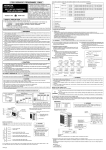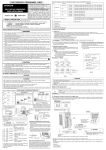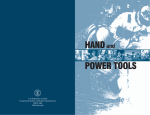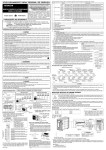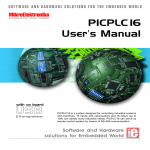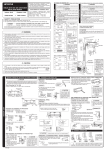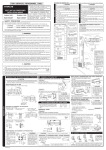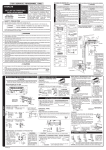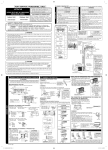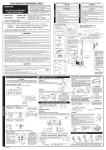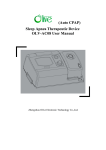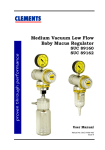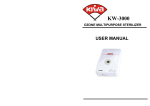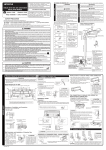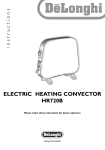Download RAM-90QH5 Installation Manual
Transcript
If you wish to prepare the copper tubes and insulation material in the field, we recommend the following. FOR SERVICE PERSONNEL ONLY ● ● SPLIT UNIT AIR CONDITIONER INSTALLATION MANUAL Outdoor Unit HFC R410A Carefully read through the procedures of proper installation before starting installation work. The sales agent should inform customers regarding the correct operation of installation. 4.0kW or less 1 Cooper tube (Mark is exclusive use tool for R410A) ● + – Screwdriver ● Measuring Tape ● Knife ● Saw ● ø 65mm Power Drill ● Hexagonal Wrench Key ( 4mm) ● Wrench (14, 17, 22, 26mm) Gas Leakage Detector ● Pipe Cutter ● Putty ● Vinyl Tape ● Pliers ● Flare Tool Vacuum Pump Adapter Manifold Valve Charge Hose Vacuum Pump 2 Flare nut Small dia. Deoxidized annealed copper pipe with 6.35mm O.D., 0.8mm wall thickness. Large dia. Deoxidized annealed copper pipe with 9.52mm O.D., 1.0mm wall thickness. Small dia. Deoxidized annealed copper pipe with 6.35mm O.D., 0.8mm wall thickness. Large dia. Deoxidized annealed copper pipe with 12.7mm O.D., 1.0mm wall thickness. 7.0kW or more Small dia. Large dia. Deoxidized annealed copper pipe with 6.35mm O.D., 0.8mm wall thickness. 4.0kW or less Small dia. Large dia. Flare nuts with 9.52mm O.D.. 5.0kW or 6.0kW Tools Needed For Installation Work RAM-90QH5 Specification Material No. 5.0kW or 6.0kW 7.0kW or more Deoxidized annealed copper pipe with 15.88mm O.D., 1.0mm wall thickness. Flare nuts with 6.35mm O.D.. Small dia. Flare nuts with 6.35mm O.D.. Large dia. Flare nuts with 12.7mm O.D.. Small dia. Flare nuts with 6.35mm O.D.. Large dia. Flare nuts with 15.88mm O.D.. SAFETY PRECAUTION ● Read the safety precautions carefully before operating the unit. ● The contents of this section are vital to ensure safety. Please pay special attention to the following sign. ! WARNING ........ Incorrect methods of installation may cause death or serious injury. ! CAUTION ......... Improper installation may result in serious consequence. Make sure to connect earth wire. This sign in the figures indicates prohibition. Be sure that the unit operates in proper condition after installation. Explain to customer the proper way of operating the unit as described in the user’s guide. ! WARNING ● Please request your sales agent or qualified technician to install your unit. Water leakage, short circuit or fire may occur if you do the installation work yourself. ● Please observe the instructions stated in the installation manual during the process of installation. Improper installation may cause water leakage, electric shock and fire. ● Make sure that the units are mounted at locations which are able to provide full support to the weight of the units. If not, the units may collapse and impose danger. ● Observe the rules and regulations of the electrical installation and the methods described in the installation manual when dealing with the electrical work. Use power cables approved by the authorities of your country. ● Be sure to use the specified wire for connecting the indoor and outdoor units. Please ensure that the connections are tight after the conductors of the wire are inserted into the terminals. Improper insertion and loose contact may cause over-heating and fire. ● Please use the specified components for installation work. Otherwise, the units may collapse or water leakage, electric shock and fire may occur. ● Be sure to use the specified piping set for R-410A. Otherwise, this may result in broken copper pipes or faults. ● When installing or removing an air conditioner, only specified refrigerant (R410A) shall be allowed, do not allow air or moisture to remain in the refrigeration cycle. Otherwise, pressure in the refrigeration cycle may become abnormally high so that a rupture may be caused. ● Be sure to ventilate fully if a refrigerant gas leak while at work. If the refrigerant gas comes into contact with fire, a poisonous gas may occur. ● After completion of installation work, check to make sure that there is no refrigeration gas leakage. If the refrigerant gas leaks into the room, coming into contact with fire in the fan-driven heater, space heater, etc., a poisonous gas may occur. ● Unauthorized modifications to the air conditioner may be dangerous. If a breakdown occurs please call a qualified air conditioner technician or electrician. Improper repairs may result in water leakage, electric shock and fire, etc. ● Be sure to connect the earth wire from the power supply wire to the outdoor unit and between the outdoor and indoor unit. Improper earthing may cause electric shock. CAUTION ! ● ● A circuit breaker must be installed in the house distribution box for the direct connected power supply wire to the outdoor unit. In case of other installations a main switch with a contact gap or more than 3.5mm has to be installed. Without a circuit breaker, the danger of electric shock exists. Do not install the unit near a location where there is flammable gas. The outdoor unit may catch fire if flammable gas leaks around it. 3 Insulation for refrigerating pipe Foamed polyethylene insulation pipe which does not corrode the copper tube. Large dia. pipe side: 15mm I.D.., 8mm wall thickness. Small dia. pipe side: 8mm I.D., 7mm wall thickness. 4 Connecting cord Refer to item 3.3. 5 Vinyl tape 6 Sealer (Putty) 7 8 Refrigerator oil Bushing for refrigerating pipes 1. Proper place for installation 1.1 Outdoor unit (1) Keep the space around the unit for maintenance and avoiding the effects of hindrance for normal ventilation of the unit. (2) The northern or eastern side of the building is better to install. At the installation on the southern or western side unavoidably, some blind should be set up for the unit. (In this case, the blind must not obstruct the ventilation of the unit.) (3) You’d better not put the unit at a place where is full of dirt and at a place where is wet in the rain. (4) Place as near as possible to the indoor unit. (5) Install the unit in a stable place to minimize vibration or noise. (6) After arranging the cords and pipes, secure them in place. ● ● ! WARNING This appliance must be earthed. Power is supplied through outdoor unit, do not connect power source to indoor unit. 2. In the electrical installation a separator with a contact gap of more than 3mm has 3.2 Connection of the connecting cords and power cord to be installed. During cleaning or service the set has to be switched off with this (1) Cut off the connecting cord, the power cord and strip the separator. insulation of the wire, as shown in Fig. 3-2. 3. Installation procedure and notice (2) Connect the connecting cord and power cord to the terminal Especially, the selection of installation place need great care for the split type air board. (Fig. 3-3-2) conditioner, because it is very difficult to move from place to place after the first (3) Fix the connecting cords and power cord with steel band installation. certainly. (Fig. 3-3-2) 3.1 Wiring Green-and-yellow (ground) (1) Those terminal blocks for connecting the indoor and outdoor cables should be installed starting from the right hand side, in a sequence of 1, 2, 3, 4, 5; in 10mm 60mm Power cord and accordance with the units’ numbering system, as illustrated in the diagram. The connecting cord left hand-most terminal block is for the power supply connection use. Detail of cutting power cord (2) The A B terminals in the terminal blocks linked to unit no. 4 and unit no. 5 are for AC 220V ~ 240V power Green-and-yellow supply connection use. As for those indoor units with inbuilt high voltage motors that are electricaly operated; (ground) the signal line (CD Line) should never be connected. Any inadvertent connection of the signal lines will 10mm damage the indoor unit’s circuit board. The four ABCD terminals are designed for those indoor units with 60mm Power cord and inbuilt high voltage motors. The installation instruction manuals that are packed together with the indoor connecting cord For Indoor Unit No. 4 (A4, B4) units should be consulted for detailed instructions. A tape that is affixed to the AB terminals to mistake Indoor Unit No. 5 (A5, B5) proof wrong connections should be removed before performing the connection. Only 2 terminals (CD) are Green-and-yellow 40mm (ground) being provided for normal indoor units. As for those indoor units that have no inbuilt high voltage motors 10mm installed, when connecting no. 4 or no. 5, use only the CD terminals and do not use AB terminals. 10mm 100mm (3) Connect the electrical wiring between the Indoor and Outdoor unit, as shown in Fig. 3-1. Never connect the Connecting cord wiring by mistake. For Indoor Unit No. 1 (C1, D1), Indoor Unit No. 2 (C2, D2), In case of wrong connection, the unit does not operate properly and it may cause malfunction. Indoor Unit No. 3 (C3, D3), Indoor Unit No. 4 (C4, D4) and (4) The connecting cord must be fixed by the band which is located near the terminal board. Indoor Unit No. 5 (C5, D5) Wiring Pattern Indoor Unit Procedures of Wiring Indoor unit No. 5 ● Be sure to tighten the flare nut to the specified torque using a torque wrench. If the flare nut is tightened excessively, it may crack as time elapses, cause refrigerant leakage. ● Please ensure smooth flow of water when installing the drain hose. ● An IEC approved power cord should be used. Power cord type: NYM. Indoor unit No. 4 Screw for ground, earth screw Terminal board A B Screw for ground, earth screw Terminal board Terminal board C D A B Fig. 3-2 Indoor unit No. 3 Screw for ground, earth screw Terminal board Indoor unit No. 2 Screw for ground, earth screw Terminal board C D C D Green-andYellow Green-andYellow Terminal board C D Green-andYellow Indoor unit No. 1 Screw for ground, earth screw Terminal board C D Green-andYellow Green-andYellow Screw for ground, earth screw Terminal board L N THE CHOICE OF MOUNTING SITE (Please note the following matters and obtain permission from customer before installation). WARNING ! ● A5 B5 Terminal board ● ● ● ● ● ● ● No. Item Figure showing the Installation of Outdoor Unit. Height difference Qty Bush 10 3 Indoor unit 3 Indoor unit 4 Indoor unit 5 ● ● ● ● ● Indoor unit 1 Indoor unit 2 Indoor unit 3 Indoor unit 4 Indoor unit 5 Outdoor unit Drain Pipe Indoor unit 1 L1 L2 L4 L3 L5 (L1 + L2 + L3 + L4 + L5) = Maximum 75m Minimum piping length for each indoor unit is 5m. Maximum piping length for one indoor unit is 15m. In case the pipe length is more than 30m, add refrigerant R410A at 15 gram per every meter exceeds. ● ● WARNING 23 ● ● ● Outdoor Unit ● If you cannot attach the side cover due to the connecting cord, press the connecting cord in direction to the front panel to fix it. Be sure that the hooks of the side cover is fixed in certainly. Otherwise water leakage may occur and this causes short circuit or faults. The connecting cord should not touch to service valve and pipes. (It becomes high temperature in heating operation.) 403 440 Face this side (suction side) of the unit to the wall. Remove side cover when connecting the piping and connecting cord. 500 [Outdoor unit installation] Mount the Outdoor unit on stable ground to prevent vibration and Before installation, the power source must be checked and necessary wiring work must be completed. To make the wiring capacity proper, use the wire gauges list below for the lead-in from a pole transformer and for the wiring from a switch board of fuse box to the main switch and outdoor unit in consideration of the locked rotor current. Do not connect indoor signal line (C, D line) to high voltage (220-240V) line (A, B line) terminals. To avoid misconnection, please refer attached terminal label as shown in Fig. 3-3-1. To avoid connecting cord scratch or clamp by side cover, it must be fix by band as shown in Fig. 3-3-2. IMPORTANT after releasing the hook by pulling it downward. 15 175 Screw for ground, earth screw For Indoor unit No. 1 Please remove the side cover for wire connection. ! When removing side plate, pull the handle 600 Screw for ground, earth screw For Indoor unit No. 2 3.3 Checking for the electric source and the voltage range Dimension of Mounting Stand of the Outdoor unit (unit: mm) 13 Screw for ground, earth screw For Indoor unit No. 3 5m 1 70 C1 D1 Terminal board The naked part of the wire core should be 10 mm and fix it to the terminal tightly. Then try to pull the individual wire to check if the contact is tight. Improper insertion may burn the terminal. Be sure to use only power cables approved from the authorities in your country. For example in Germany: Cable type: NYM 3x2.5mm 2. (fuse = 30A time delay) Please refer to the installation manual for wire connection to the terminals of the units. The cabling must meet the standards of electrical installation. There is a AC voltage of 220-240V between the L and N terminals. Therefore, before servicing, be sure to remove the plug from the AC outlet or switch off the main switch. Indoor unit 2 11 C2 D2 Terminal board Wiring of The Outdoor Unit Piping length Height difference between indoor units should be not more than 5m. C3 D3 Terminal board ! WARNING Do not expose the unit under direct sunshine or rain. Besides, ventilation must be good and clear of obstruction. The air blown out of the unit should not point directly to animals or plants. The clearances of the unit from top, left, right and front are specified in figure below. At least 3 of the above sides must be open air. Be sure that the hot air blown out of the unit and noise do not disturb the neighbourhood. Do not install at a location where there is flammable gas, steam, oil and smoke. The location must be convenient for water drainage. Place the Outdoor unit and its connecting cord at least 1m away from the antenna or signal line of television, radio or telephone. This is to avoid noise interference. Names of Outdoor Components C4 D4 Terminal board Screw for ground, earth screw For Indoor unit No. 4 Fig. 3-1 Power cord CAUTION ! A4 B4 Terminal board Screw for ground, earth screw For Indoor unit No. 5 Green-andYellow The Outdoor unit must be mounted at a location which can support heavy weight. Otherwise, noise and vibration will increase. C5 D5 Terminal board Cable length Wire cross-section up to 16m up to 15m up to 25m 1.5mm2 2.5mm2 4.0mm2 ! WARNING ● Connect the Connecting Cord to C1 and D1 “Indoor 1” for indoor unit 1, C2 and D2 “Indoor 2” for indoor unit 2, C3 and D3 “Indoor 3” for indoor unit 3, C4 and D4 “Indoor 4” for indoor unit 4 and C5 and D5 “Indoor 5” for indoor unit 5. Bind connecting cords to make them fit between the convex sections. increase of noise level. Decide the location for piping after sorting out the different types of Pull downward pipe available. CAUTION ! Outdoor unit pipe connection port Make sure to connect to two or more indoor units. Indoor unit 5 Indoor unit 4 Indoor unit 3 Indoor unit 2 Indoor unit 1 ● The flare adaptor for piping is required depending on combination of indoor units. • ø9.52 (3/8”) ➝ ø 12.7 (1/2”) Parts number TA261D-4 001 • ø12.7(1/2”) ➝ ø 9.52 (3/8”) Parts number TA261D-6 002 • ø12.7(1/2”) ➝ ø 15.88(5/8”) Parts number TA261D-6 003 One unit of 1.8kW, 2.5kW, 3.5kW, 5.0kW or 6.0kW (5.0kW, 6.0kW unit: Optional flare adaptor for piping is necessary.) One unit of 1.8kW, 2.5kW, 3.5kW, 5.0kW or 6.0kW (5.0kW, 6.0kW unit: Optional flare adaptor for piping is necessary.) One unit of 1.8kW, 2.5kW, 3.5kW, 5.0kW, 6.0kW or 7.1kW (1.8-3.5kW unit: Optional flare adaptor for piping is necessary.) To the outdoor unit, up to five indoor units can be connected until the total value of each units’s capacity reaches 15.5 kW. The pipe connection ports of the outdoor unit and connectable indoor units are shown above. <IA214: A > AC200-240V LN BASE DRAIN PIPE INDOOR 5 INDOOR 5 INDOOR 4 INDOOR 4 INDOOR 3 INDOOR 2 INDOOR 1 A5 B5 C5 D5 A4 B4 C4 D4 C3 D3 C2 D2 C1 D1 After remove the screw and cover, put the connecting cords and fix the cover with screw Fig. 3-3-1 A One unit of 1.8kW, 2.5kW, 3.5kW, 5.0kW or 6.0kW (5.0kW, 6.0kW unit: Optional flare adaptor for piping is necessary.) One unit of 1.8kW, 2.5kW, 3.5kW, 5.0kW, 6.0kW or 7.1kW (1.8-3.5kW unit: Optional flare adaptor for piping is necessary.) Connect the earth cord CONDENSED WATER DISPOSAL OF OUTDOOR UNIT There are holes on the base of Outdoor unit for condensed water to exhaust. In order to flow condensed water to the drain, the unit is installed on a stand or a block so that the unit is 100mm above the ground as shown figure. Join the drain pipe to one hole. At first insert one portion of the hook to the base (Portion A), then pull the drain pipe in the direction shown by the arrow while inserting the hook into the base. After installation, check whether the drain pipe cling to the base firmly. Type of grounding rod 100 mm ABOVE Flare adaptor for piping SP-EB-2 10 Grounding rod (optional) (Earth wire and grounding rod are not supplied. Please use optional items below.) BUSH 11 Length 900mm ! CAUTION Fig. 3-3-2 Arrange power cord so they do not touch service valve. DRAIN PIPE When Using and Installing In Cold Areas When the air conditioner is used in low temperature and in snowy conditions, water from the heat exchanger may freeze on the base surface to cause poor drainage. When using the air conditioner in such areas, do not install the bushings. Keep a minimum of 250mm between the drain hole and the ground. When using the drain pipe, consult your sales agent. For more details, refer to the installation Manual for Cold Areas. ● Investigate the power supply capacity and other electrical conditions at the installation location. Depending on the model of room air conditioner to be installed, request the customer to make arrangements for the necessary electrical work etc. The electrical work includes the wiring work up the outlet. In localities where electrical conditions are poor, use of a voltage regulation is recommended. IMPORTANT Fuse Capacity 30A time delay fuse 4. Preparation of Pipe Gas leakage inspection Use a pipe cutter to cut the copper pipe. ! CAUTION Please use gas leakage detector to check if leakage occurs at connection of flare nut as shown on the right. Trimming tool Jagged edge will cause leakage. Point the side to be trimmed downwards during trimming to prevent copper chips from entering the pipe. ● ● Copper pipe ● Before flaring, please put on the flare nut. Die Die A Copper pipe ● Please use exclusive tool 7. Operation test A (mm) Outer Diameter (Ø) Imperial flaring tool 6.35 (1/4”) 0 9.52 (3/8”) 0 12.7 (1/2”) 0 15.88 (5/8”) 0 ~ ~ ~ ~ 0.5mm 1.0mm 0.5mm 1.0mm 0.5mm 1.0mm 0.5mm 1.0mm ● ● ● Outer diameter of pipe (Ø) Torque N·m (kgf · cm) 6.35 (1/4”) 13.7-18.6 (140-190) 9.52 (3/8”) 34.3-44.1 (350-450) 12.7 (1/2”) 44.1-53.9 (450-550) 15.88 (5/8”) 49.0-58.8 (500-600) Small diameter side 6.35 (1/4”) 9.52 (3/8”) 19.6-24.5 (200-250) 19.6-24.5 (200-250) Large diameter side 12.7 (1/2”) 15.88 (5/8”) 29.4-34.3 (300-350) 29.4-34.3 (300-350) 12.3-15.7 (125-160) Small diameter side Torque wrench Valve head cap Trial run should be conducted on one unit at a time to check for incorrect wiring of connecting cord. Valve core cap Install the unit in a stable place to minimize vibration or noise. After arranging the cords and pipes, secure them in place. Position of service switch and self-diagnosis lamp as below. (1) Switching on the outdoor unit’s service switch will run the forced cooling operation. (2) After operating for around 5 minutes, rotate the service valve spindle located at the side of the small pipe rim, in a clockwise direction to achieve a full shut off. (3) After operating for around 2~3 minutes, rotate the service valve spindle located at the side of the large pipe rim, in a clockwise direction to attain a full shut off. (4) Immediately stop the forced cooling operation and switch off the power supply. (5) Use a spanner or similar tools to tighten fully all valve cap and valve core cap to their specified torque values. (6) Install and tighten the seal caps and flared nuts on all connecting mouths of each and every piping installed. Please be careful when bending the copper pipe. Screw in manually while adjusting the center. After that, use of torque wrench to tighten the connection. Wrench CAUTION 8. Recovery of refrigerant during relocation or uninstalling of unit Do not tighten all at once, but tighten it while fitting the flared surface to the pipe. Large diameter side ● ! In case of removing flare nut of a indoor unit, first remove a nut of small diameter side, or seal cap of large diameter side will fly out. Free from water into the piping when working. During connection, keep away from water. Be sure to tighten the flare nut to the specified torque using a torque wrench. If the flare nut is tightened excessively, it may crack as time elapses, causing refrigerant leakage. Flare nut ● ● Please ensure that the air conditioner is in normal operating condition during the operation test. Explain to your customer the proper operation procedures as described in the user’s manual. If the indoor unit does not operate, check to see that the connections are correct. Tighten all the way by hand. (1) Remove the flare nut and seal cap from the service valve. (2) Apply refrigerator oil to the service valve and the flared portion of the pipe. (3) Using a wrench, security tighten. ● ● ● 5.1 Pipe connection Connecting the pipe to outdoor unit ● ● Rigid flaring tool 5. Pipe Connection ! CAUTION If gas leakage occurs, further tighten the connection to stop leakage. (Use the detector provided for R410A) C D C D Pressing the outdoor unit’s service switch for 1 second will start the forced cooling operation. Please run this operation whenever there is a need to perform trouble-shooting or recovery of outdoor unit’s refrigerant. ! Service switch Fig. 6-4 CAUTION: In the event that the service valve spindle had been closed, do not operate it for more than 5 minutes. 5 ROOM MULTI-SPLIT INVERTER TYPE ROOM AIR CONDITIONER POSSIBLE COMBINATION TO OPERATE (SAME TIME OPERATION) Pipe connection port for Indoor unit No. 2 Indoor unit No. 1 Pipe connection port for Indoor unit No. 3 Indoor unit No. 2 Indoor unit No. 3 Indoor unit No. 4 Indoor unit No. 5 6. Removal Of Air From The Pipe And Gas Leakage Inspection This system integrates 5 sub-systems of piping with 1 pair of service valves installed. That pair will be used for air purging and pumping down operations. Furthermore, due to valves are not installed to cover up the connecting mouths, there is a need for all unutilized connecting mouths to be tightly covered up by seal caps and flared nuts. CAUTION: Should all unutilized connecting mouths are not tightly covered up by seal caps and flared nuts, there will be potential gas leaks occurring. 6.1 Air purging by using vacuum pump Remove the valve cap from the service valves located at both the large and small pipe rims ➤ After removing the valve cap of the valve core of the service valves located at the large pipe rim, connect the charging hose A. When the meter reaches -101KPa (-76cmHg) during pumping, fully tighten the shuttle. Meter showing pressure 12.6 12.4 12.6 9.7 11.8 12.8 12.8 12.6 12.7 11.5 11.4 11.5 8.9 10.8 11.7 11.7 11.6 11.7 3.28 3.32 3.28 3.54 3.32 3.24 3.24 3.27 3.25 ➤ Closed After connecting the vacuum suction pump adaptor, connect the charging hose B to the adaptor. Lo Hi Charge hose B Charge hose A ➤ During relocation or at any one time when the air conditioner unit is removed and re-installed, there is a possibility of getting a closed electricpowered valve. Should the electric-powered valve be closed, even with air purging being conducted, certain amount of air is still trapped within that area, hence, there is a need to open up the electric-powered valve to do an air purging. Under such circumstances, before using the vacuumsuction pump, the main power supply (LN terminal) should be connected to enable a complete opening up of the valve. After connecting the power supply for approximately 90 seconds, the valve will be fully opened up, after which disconnect the power supply and start using the vacuum suction pump. (Refer to “Power Supply Terminal Connections” in regards to the LN terminal) CAUTION: Ingress of air during the operating cycle may cause increase in pressure and other breakdowns. 2740 2710 2740 2120 2560 2780 2780 2750 2770 Air purging by vacuum pump R410A Manifold valve Stop valve Vacuum pump Stop valve Vacuum pump adapter Be sure the stop valve is always fully opened. Fig. 6-1 1.88 1.88 3.22 3.22 ➤ Switch off the outdoor unit’s power supply Valve cap ➤ Shutting off via the manifold valve handle Hi, the handle Lo will open up and operate the vacuum pump that will run a vacuum suction for approximately 60 minutes. Valve cap of valve core 1.8+3.5+3.5+5.0 1.15+2.30+2.30+3.25 9.00 2530 1.65 2.85 2.85 2.85 1.56 2.69 2.69 4.06 ➤ Upon a full shut off via the manifold valve handle Lo, the vacuum pump will stop operating. ➤ Valve cap Check to ensure that there is no gas leakage. Fig. 6-2 ➤ 2.18 2.74 2.74 2.74 After removing the charging hose A, rotate the service valve spindles (2 units on both sides) in an anti-clockwise direction to fully open up. Valve cap ➤ Reinstall the cap nuts to their original positions and tighten them to their specified torque values. Valve cap of valve core Stopper O-Ring Pipe ➤ Disconnect the charge hose from the service valve. ➤ Tighten the valve cap of valve core. [Torque 12.3 - 15.7 N·m (125 - 160 kgf·cm)] ➤ Attach the valve cap to the spindles of each large and small dia. pipe side service valves. ➤ Tighten the valve cap of the spindle. [Torque 19.6 - 24.5 N·m (200 - 250 kgf·cm)] <IA214: A > Valve core Seal cap Flare nut Pipe Spindle Fig. 6-3 The refrigerant channel is opened so that the refrigerant will flow from the outdoor unit into the indoor unit. C D 9. Forced Cooling Operation Pipe connection port for Indoor unit No. 1 Pipe connection port for Indoor unit No. 5 C D Green led Red led Connecting cord should have arranged wit h piping using tape previously. Pipe connection port for Indoor unit No. 4 C D v ● (Reference value)


